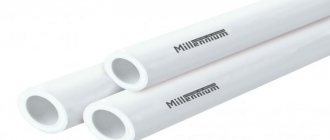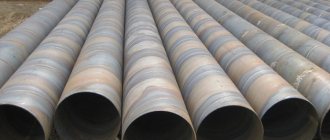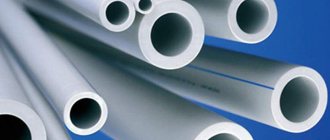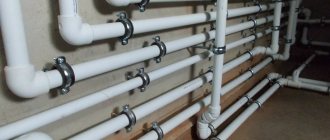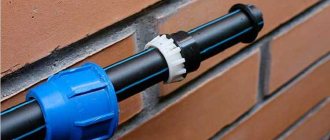Installing a heating system is a long and labor-intensive process. Previously, metal or cast iron products were used; they have many disadvantages, which makes the process of their operation inconvenient.
An excellent option for pipes for this case are polypropylene, as they are able to properly organize the circulation of the heat carrier, which comes directly from the boiler. In addition, such products are flexible and plastic. They are great for installing heated floors. Polypropylene pipes are universal. They can be used with various components of the heating system. They are distinguished by high quality and simple installation process, resistance to adverse factors and long service life.
What are the advantages of polypropylene pipes for hot water?
Polypropylene pipes are a universal material. But more often they are used in cold and hot water supply systems. Polypropylene pipes began to be used in heating after manufacturers offered a reinforced version. These are products that have a reinforcing frame made of aluminum foil inside them.
Propylene pipe
And if in private houses non-reinforced models can be installed in heating systems, because the pressure in the network does not exceed 3 Bar (this is 0.3 MPa), then in apartments it is impossible to do without a reinforced frame. It's all about the pressure of hot water supplied from the boiler rooms.
The liquid is supplied using pumps that pump it to certain values, the indicator of which depends on the number of floors of the building.
Eg:
- Five-story buildings of old construction, in which cast iron batteries are installed. Hot water is supplied here under a pressure of 7 bar.
- In the nine-story buildings, which were built during the Soviet Union, hot water is supplied under a pressure of 5 bar. In some houses, water pressure can reach up to 10 bar.
- In new buildings - at a pressure of 15 bar.
An unreinforced polypropylene pipe may not withstand such pressure.
As for temperature, polymer products of this type can easily withstand the load of hot water +95 ℃. Or short-term exposure to liquid with a temperature of +110 ℃.
Advantages of polypropylene pipes for hot water:
- Long-term operation – up to 50 years.
- Easy to maintain. There is no need to cover the surface of the highway with other finishing materials. For example, paint, as usually happens with steel analogues.
- They easily tolerate alkaline and slightly acidic environments. Under their influence, the polymer does not change its characteristics. Hence the long-term operation, because in many regions hot and cold water have increased hardness.
- Layers of dirt, rust and other substances never form on the internal surfaces. Therefore, the diameter of polypropylene pipes is always the same, hence the stable operation of water supply and heating networks.
- The thermal conductivity of polypropylene is very low. The hot water flowing inside them practically does not lose heat.
- Almost one hundred percent frost resistance. If for some reason the hot water supply or heating system suddenly freezes, then the water inside the pipes will freeze, but the polymer products themselves will not burst. The utility network will remain in good technical condition. After defrosting, it can be put into operation again.
- Polypropylene has good noise absorption. The sounds of hot water moving inside the network are not heard. Such a system also rarely vibrates.
- The hardness of the material is sufficient to withstand heavy loads. At a water temperature of +140 ℃, the polymer softens, which is why the strength can sharply decrease. It returns to its original value as soon as the indicators begin to decrease.
- Polypropylene pipes used for transporting hot water are an environmentally friendly material. Under the influence of changes in humidity, temperature and other loads, it does not emit substances harmful to the body. This is especially important in the water supply system.
- Easy installation. To do this, you only need a soldering iron and a few more simple tools. The whole process boils down to cutting the pipes to the correct size and connecting them to each other using fittings according to the pipeline layout.
- Polymer is an inexpensive material. Hence the relatively low price of polypropylene pipes.
Polypropylene pipes have one drawback - linear expansion under the influence of hot water. But this problem is solved by installing a reinforcing frame inside the product. It is reinforced pipes that are installed today in hot water supply and heating systems.
Aluminum reinforced polypropylene pipe
Marking
Almost any product is presented in different versions. Polypropylene pipes were no exception. They come in several types. At the same time, they differ not only in external characteristics, but also in other parameters that relate to the technical level. To systematize and simplify this process, experts have developed their own system. It consists in putting numbers and letters on the product, that is, markings.
As for this type of pipe, it is different and depends on many indicators. These include the design pressure, pipeline diameter, product thickness, date of manufacture, manufacturer's brand, batch number and certificate.
Thus, the marking is presented in the form PN and 10, 16, 20, 25, as shown in the photo. The letters indicate the nominal pressure of the product, and the numbers indicate the nominal operating pressure in atmospheres. Together, they determine the purpose of the pipe and its service life.
Reinforced polypropylene pipes for hot water
Reinforcement is carried out in different ways:
- Using a solid sheet of aluminum. It can be laid on the outside, on the inside or in the middle of the wall of polypropylene pipes.
- A perforated aluminum sheet is used, which is laid only on the outside.
- Fiberglass is used, which is installed in the middle.
- The composite material used is a mixture of polypropylene and fiberglass.
Aluminum reinforcement has disadvantages. Aluminum itself, although it is an anti-corrosion material, begins to oxidize over time under the influence of salts and active substances found in hot water. Therefore, at the ends of the pipes you can often see traces of metal corrosion, which gradually lead to a decrease in the quality of the product and the system as a whole.
In this regard, non-aluminum reinforcement is considered the best option. This relates to the question of which polypropylene pipe is better for hot water.
Distinctive features of products with non-aluminum reinforcement:
- there is no need to clean the ends when soldering two pipe elements, and this requires a special tool;
- the fiberglass reinforced frame is not glued, but welded, so the polypropylene pipe for hot water cannot delaminate;
- Electrochemical processes do not occur because there is no metal in the body of the product.
Glass fiber reinforcement
Initial stage of work
Any installation of water pipes begins with drawing up a project. The scheme must be well designed, otherwise the pipeline system will not be able to function properly. This does not mean that the project should become a miracle of engineering - the main thing is that you can easily navigate the finished circuit, so that if errors arise during the work, you can easily figure it out and quickly solve them.
The project must contain the following information:
- Soil properties - its type, whether it is loose, rocky or sandy.
- The area of land over which the pipe will be laid. It is necessary to calculate so that you can always consider the number of forks and entrances.
Remember that the laying of water supply pipes must pass along a pre-leveled area. Ignoring this nuance may lead to unexpected bad consequences in the near future.
How to install polypropylene pipes for hot water
The installation of a plastic hot water pipeline is based on the soldering process, through which polypropylene pipes are connected. This does not happen directly, but through fittings. There is also a direct method, but it requires special equipment.
At home, a hand-held device called a soldering iron is used to make connections. It comes with nozzles for standard pipe sizes. With their help, the polymer material is melted. They are mounted on a soldering iron, which is heated by a heating element. Heating temperature – +260 ℃. It is set on the soldering iron using a thermostat.
Temperature is an important indicator on which the quality of the connection depends. If it is low, the polymer will not soften to the required state. The joint will be leaky. If you overheat, the material, on the contrary, will become too soft, which will lead to deformation of pipes and fittings.
Installation process:
- A preliminary diagram of the plumbing or heating wiring is drawn up.
- Polypropylene pipes are cut into pieces with precise measurements of the areas where they will be installed.
- The edges are cleaned. If aluminum-reinforced products were selected, then the frame must be removed to the length of the connection.
- The soldering iron is plugged into the outlet. It must be heated to the required temperature, which will be indicated by the light on the device. It will go out.
- On one side, a fitting is put on the pin nozzle, on the other hand, a pipe is inserted into a nozzle similar to a sleeve. It warms up for 15-20 seconds.
- The connection elements are removed from the nozzles and inserted into each other until they stop.
- In five seconds, a strong and reliable joint is ready.
In this way, all elements of the pipe structure are connected to each other. After which the hot water supply or heating system must be filled with water and checked for leaks at the connections. If none are found, it means the installation was successful.
Soldering polypropylene pipes for hot water
Basic requirements for pipes for water supply in the ground
Digging wells and drilling wells are quite expensive activities, so residents of private houses increasingly prefer installing underground water supply. The optimal type of pipe should be selected depending on many factors: the purpose of the water supply system, the length of the section, and the budget. There are several general requirements that all pipes for underground water supply must meet:
- Quality. Pipes must be produced in accordance with technological standards, their surface must be flat, smooth, without any dents, creases or bulges.
- Reliability. This implies resistance to mechanical stress and the ability to withstand high pressure.
- Durability. The material from which the pipe is made must be wear-resistant and not subject to biological factors: corrosion, rust, or exposure to rodents.
- Resistant to sudden temperature changes. Resistance to soil freezing is also taken into account. Even a well-insulated pipe will experience constant thermal changes, which should not affect its performance.
Also, pipes for water supply in the ground, especially those intended for supplying drinking water, must be made of environmentally friendly material. Then the water passing through them will remain transparent, and foreign odors and impurities will not be detected in it.
The quality of the pipes determines the purity of the water and its suitability for drinking.
Areas of use
The use of flexible pipes in laying communications is found almost everywhere today. There is practically no area where such pipes cannot be used. Among the main directions it is worth highlighting:
- water supply system. In this case, flexible water supply is ideal for both cold and hot water supply, due to improved technical characteristics by applying a special heat-insulating layer;
- laying communication channels. You can often find cables hidden inside flexible tubes. Thus, there is no need to worry about the safety of the wires, since they are reliably protected from external influences. The laying of communications in the city is often carried out using flexible steel pipes, since they have the greatest strength;
- gas supply system;
- ventilation system;
- heat supply system;
Causes of normal spontaneous erection
Spontaneous erection (SE) is most often a variant of the norm. It is formed long before the appearance of sexual desire. The first uncontrollable erections may appear in infants. In adolescent and adult men, SE can normally occur spontaneously at night every 2 hours.
This condition is especially typical in the morning; it is an indicator of sexual health. If nocturnal spontaneous erections are absent or their number is reduced, then this may be one of the first signs of some disease, for example, atherosclerosis, diabetes, etc.
Frequent nocturnal SEs are not associated with sexual arousal; the reasons for their development have not yet been precisely established. But there is enough scientific material where experts link their occurrence:
- with maintaining the vessels of the genital organ in working condition;
- with fullness of the bladder or rectum;
- with overflow of the seminal vesicles due to sexual abstinence;
- with increased secretion of testosterone during night sleep.
In boys during puberty, involuntary erections may appear during the daytime. This is also one of the normal options for guys. In adult men, daytime spontaneous erections are much less common and are often associated with sexual abstinence or some kind of disease.
Night erection
One type of spontaneous erection is considered to be nocturnal. It arises for several reasons:
A man has erotic dreams. This is the rarest reason, but it can also indicate the normal development of the male body
It is important to understand that a man cannot control and remember such dreams, so it is simply pointless to be offended by him in the morning; Renewal of blood flow. In order to maintain normal elasticity of the head and other cavernous bodies, the body itself optimizes and tests the performance of the penis
As a result, 3-5 such tests can occur per night, each lasting up to 3 minutes; Spermatotoxicosis. If a man abstains from intercourse and masturbation for a long time, then there is a high probability that he will experience sperm stagnation. The body increases the sensitivity of organs in order to throw out outdated genetic material. Usually an erection as a result of spermatotoxicosis ends with a sudden ejaculation, which is called a wet dream.
Peculiarities
Flexible pipes, regardless of their material, are endowed with a number of features. Of course, they are a real salvation when laying or replacing pipes in difficult areas. The main advantage of such a pipeline over others is the ability to bend it at any angle. A pipeline assembled from such elements is completely protected from corrosion. Of course, plastic products are not subject to rust at all, while steel products are coated with anti-corrosion compounds.
Causes
There are organic and psychogenic impotence. The organic form is characterized by certain deviations in the human body, that is, the internal state acts as a provocateur. The psychogenic cause is associated with the psycho-emotional state of a person; he probably experiences fear, prolonged stress, and depression. The treatment is the normalization of the psychological state, which is achieved through good rest.
Organic
Organic impotence is divided according to the type of system affected. Organic erectile dysfunction has a main symptom - prolonged development. The male body experiences difficulty with erection or ejaculation in a progressive form. Many men attribute this to fatigue and do not pay proper attention, which leads to a serious form of impotence.
Neurogenic
Symptoms of neurogenic erectile dysfunction appear gradually, often due to back injuries or various lesions of the parasympathetic nerve fibers. Scientists have noticed that with injuries to the lower spinal cord, male impotence develops quite quickly. Modern medicine can restore sexual health in only 25% of men with spinal cord damage.
Vascular
Vascular impotence develops due to improper blood circulation. In a normal situation, blood is quickly pumped into the cavernous bodies of the genital organ and creates high pressure there. To maintain the proper level of compression, the correct functioning of the sphincters is necessary, which block the rapid venous outflow of blood.
With the vascular type, there is no rapid blood flow or the outflow is not blocked. With a lack of blood pressure, the organ increases in size, but this is not enough for full sexual intercourse or the erection disappears before ejaculation occurs. Penis flaccidity occurs when:
- Having had a stroke or heart attack;
- Anemia;
- Hypotension;
- Atherosclerosis;
- Pathologies of the cardiovascular system;
- Insufficient blood flow.
Endocrine
Hormonal balance has a direct impact on the functioning of the reproductive system, and the endocrine system occupies a significant place among the organs capable of secreting hormones. Testosterone is a “male” hormone that plays a primary role in potency. Lack of testosterone leads to impotence.
Thus, adult men (45 years of age or more) face periodic loss of potency, although erectile dysfunction is temporary; hormonal levels need to be restored at the stage of symptom detection. Endocrine forms of diseases are complex in that they have a long recovery period, but it all depends on the cause of the deviation.
Psychogenic
The lack of male power can be provoked by a psychological factor; often the problem is aggravated by the characteristics of the reproductive system, for example, curvature of the shaft of the penis or disproportionate enlargement of the head of the organ.
The main cause of the psychogenic form is psychoemotional dysfunction. At the same time, the man’s body is full-fledged, but there is no psychological potential. Common causes of psychogenic erectile dysfunction:
- Low self-esteem, feeling of unworthiness of a partner;
- Long-term depression and nervous tension;
- Apathy towards sexual intercourse;
- Bad experience;
- Criticism of a man by his partner;
- Restless state;
- Stress.
Treatment of the psychogenic form can be more difficult than any type of organic impotence. Sometimes you can’t do without the help of a psychiatrist.
Reasons why men have tetanus in the morning
For several decades, scientists have been researching the reasons that cause morning erections. But the experts did not come to a definite answer. Common known theories why men have stiffness in the morning are as follows:
- Excessive bladder fullness. A bladder completely filled with urine puts pressure on the walls of the prostate gland, triggering the occurrence of involuntary nerve impulses that are transmitted to the brain. In men, the same part of the brain (pons) controls the process of both arousal and urination. An overfilled bladder stimulates the nerve endings, and this causes a morning erection.
- Hormonal activity - a surge of testosterone. During REM sleep, due to increased activity of the cerebral cortex, an increased production of the male hormone testosterone occurs in a man’s body. Its maximum release is observed in the morning period from 6 to 8 – 9 o’clock. It is this surge of the male hormone that causes an active process of involuntary arousal of the genital organ.
- Impact of natural sleep phases. Conventionally, the sleep period is divided into two phases: slow and fast. In slow-wave sleep, the entire body relaxes completely, all biorhythms are slowed down. In the REM sleep phase, the brain is activated and a “check” of all organs and systems is launched.
As a result of the research, experts came to the conclusion: in a calm state, the penis receives minimal arterial blood flow. As a result of the lack of spontaneous erections, hypoxia (oxygen starvation) of the penis tissues may occur. With complete relaxation of the body, the erect state of the organ occurs 4–6 times and lasts 10–20 minutes. The body spontaneously increases blood circulation in the organ, prevents hypoxia, and as a result, the sexual health of the man is preserved.
- Dreams of an erotic nature. Dreaming involves direct visual representation; many images in dreams appear clearly and fully, which leads to sexual arousal. Just before waking up, blood flow to the man’s genitals increases to the maximum, and this causes an involuntary long-term erection. However, the presence of constant erotic dreams indicates a certain problem and requires contacting a sexologist.
- The use of drugs to enhance potency. A persistent morning erection that lasts long enough can be a side effect after taking Viagra or Cialis, drugs that contain sildenafil and tadalafil.
- Periodic full blood flow to the penis. The process occurs more often in single men, whose penis erugation, for natural reasons (excitement), occurs very rarely, who do not have regular sex or occur several times a year.
Experts say: a morning erection is very beneficial for the male body. During this period, activation of oxygen metabolism occurs in the genital organ, active renewal occurs in the arterial blood flow, and nutritional exchanges intensify. As a result, the body spontaneously prevents congestion, prevents hypoxia of organ tissue, impotence, and activates the performance of the reproductive system.
